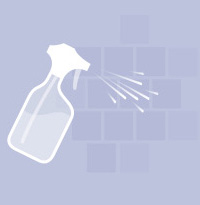 story by Leah R. TroianoAs a kid, my Saturday-morning chores included cleaning the bathroom. Like most kids, I wasn’t a huge fan of any chores, but the bathroom was particularly difficult for me. Much to my parents’ displeasure, I cleaned as quickly as possible while holding my breath, dashing in and out of the room for gulps of fresh air. If I didn’t hold my breath, my nose was affected and my sense of smell was gone for a short time afterward.
story by Leah R. TroianoAs a kid, my Saturday-morning chores included cleaning the bathroom. Like most kids, I wasn’t a huge fan of any chores, but the bathroom was particularly difficult for me. Much to my parents’ displeasure, I cleaned as quickly as possible while holding my breath, dashing in and out of the room for gulps of fresh air. If I didn’t hold my breath, my nose was affected and my sense of smell was gone for a short time afterward.
Many years later, I have my own bathrooms to clean. But the cleaners haven’t changed all that much. When I started my research for a non-toxic cleaner, I wasn’t surprised to find that bathroom cleaners often contain some of the harshest chemicals found in our household cleaning supplies. Chemicals such as chlorine bleach and ammonia (and many more) may clean well, but they can also damage our nervous and respiratory systems if inhaled. It’s no wonder many bathroom cleaners carry warning labels requiring use “in well ventilated areas,” which translates to: “Do not inhale the fumes.”
Often the toxicity doesn’t end with the cleaning job. All cleaning products leave residue behind. (If you can smell it, it’s still there.) When you take that first hot, steamy shower, the residue mixes with the steam and becomes a vapor, which we breathe in while we lather up.
However, good hygiene is a must (especially in the bathroom), so here’s a non-toxic alternative that will leave your bathroom clean, disinfected and smelling great.
Leah R. Troiano, a certified cancer support educator, works with people who have cancer or would like to prevent cancer. Lowering toxicity is just one of many ways to get your body in cancer-fighting shape. For more information, visit CancerHealthandWellness.com or e-mail Leah@CancerHealthandWellness.com
How to Make Your Own Bathroom Cleaner
- 1 ½ cup baking soda
- ¼ cup water
- ½ cup castile soap
- 10 drops of tea tree oil
- 20 drops of essential oil (if the castile soap does not have a fragrance)
- white distilled vinegar
- clean spray bottle
Directions
- In a glass bowl or recycled jar, add the baking soda, water, castile soap and tea tree oil. Then add essential oils, if needed. (For tough-to-remove stains or soap scum, you can add an additional 1/2 cup of baking soda to the mixture.) Mix well.
- Add the white vinegar to a clean spray bottle.
- To use, spray the area to be cleaned with the white vinegar.
- Apply the cleaning mixture to your scrub brush or sponge.
- Scrub the surface you sprayed with vinegar in a circular motion. Rinse well. For grout stains, scoop the cleaning mixture onto the bristles of an old toothbrush and scrub.
*With this and all new cleaners, always test an inconspicuous area before cleaning to ensure the product is safe to use.
Cleaning on the Fly: A down and not-so-dirty quick fix





I love this article. You really help me a lot. Thank you very much!
I love this article. You really help me a lot. Thank you very much!
I started looking for less-toxic, greener alternatives a few years ago. It's hard! You can whip up your own natural cleaners with lemons, vinegar, baking soda and water, which is pretty cool, but I'm too lazy to do that, so I buy commercial items. It's pricier than making my own, but at least the "natural" alternatives leave a fresh, nice smelling house instead of a light head like the conventional stuff. I even look forward to using it – it's the only nice thing about cleaning
I started looking for less-toxic, greener alternatives a few years ago. It's hard! You can whip up your own natural cleaners with lemons, vinegar, baking soda and water, which is pretty cool, but I'm too lazy to do that, so I buy commercial items. It's pricier than making my own, but at least the "natural" alternatives leave a fresh, nice smelling house instead of a light head like the conventional stuff. I even look forward to using it – it's the only nice thing about cleaning